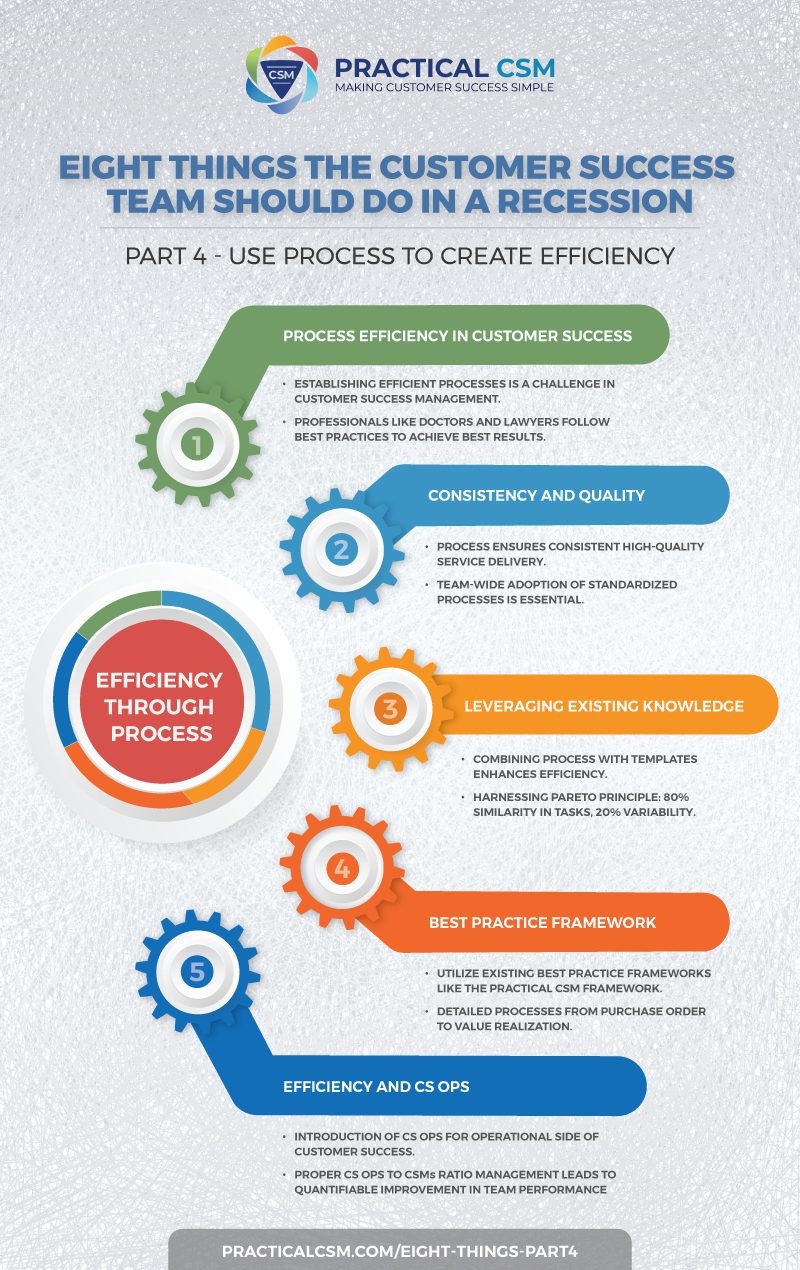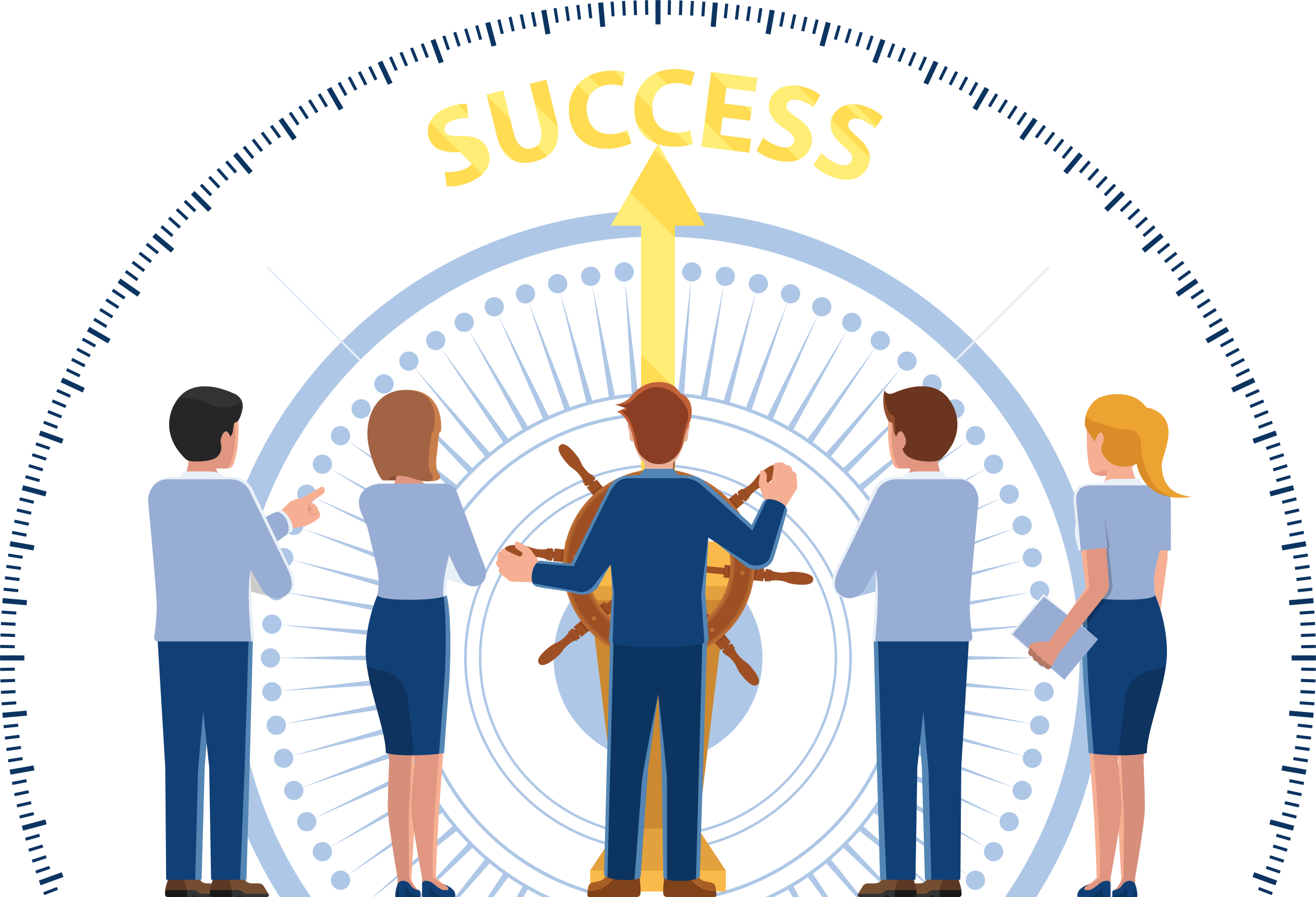Use Process to Create Efficiency
Eight Things the Customer Success Team Should Do in a Recession – Part 4
Overview
There were a lot of great points made in my recent interview with Nick Mehta, CEO of Gainsight, but there was one aspect of the interview in particular that I think was particularly important. This was the part of our conversation when we discussed the role of the Customer Success Management team during a recession, or during any period of uncertainty where businesses are tightening up budgets and only performing essential activities due to fear of an impending recession, which I think is a good description for the situation we find ourselves in right now.
This article is partially based upon my recent discussion with Nick Mehta, and describes eight practical steps that almost any Customer Success Management team should be able to take when faced with a recession or period of uncertainty. In fact, to be exactly accurate we will discuss seven things to do and one thing to avoid doing. The original interview that inspired this article was recorded and the recording is available from our website here and from our YouTube channel here.
The eight practical steps we will be covering in this article are:
- Proactively Offer Your Help
- Address Your Client’s Current Priorities
- Measure and Prove the Value
- Use Process to Create Efficiency
- Automate Customer Success Management
- Leverage the Power of Client Communities
- Make Your Product an Essential Need
- Do Not Become the Concierge

Use Process to Create Efficiency
Let’s now turn our attention to something that I think can sometimes be more of an issue for Customer Success Managers than for other customer-facing professionals. This is because what we are about to discuss is closely tied to best practice, and frankly many Customer Success teams seem to have as yet managed to mature their working methodologies into a set of scalable, repeatable, reliable, high quality processes.
Think about how other professionals work for a moment. Doctors, lawyers, accountants, architects, and so on, all go about their business by following best practices. They have a process to follow and they know that if they follow the process as accurately as possible, the best result will ensue. If they stop following best practice (for example by cutting corners by skipping certain steps), not only do they run the risk of producing a poor quality end result, but they also run the further and potentially greater reaching risk of losing credibility or even of being sued for malpractice.
Would you go to a dentist if that dentist had a reputation for cutting corners in their work? Would you take a brand new and precious automobile to a mechanic that was known for not following best practices? Of course not – not even if it saved a little money! So why would it be any different for your customers when they are looking for the right technology solution provider to leave their highly precious business outcomes in the hands of?
So in fact the first reason why we need process is because following the right processes allows us to maintain a consistent level of quality of service to our customers across the whole team (assuming all team members follow the same processes of course, which naturally they absolutely should).
But there is another and potentially equally valid reason for following the process, and that is to do with efficiency. Let me ask you a question, and please be honest with your answer because since I am not really there, answering dishonestly is in fact only being dishonest with yourself. Here is my question: When was the last time you found yourself writing a lengthy (ie several paragraphs) explanatory email to a customer stakeholder that is either exactly the same as or at least very similar to other emails you have previously sent to other stakeholders of the same or other customers, but who have effectively asked you the same question, or described the same challenge? For the better-organized amongst us I guess it is possible that they might say “I cannot remember when”, but I am certain that for at least someone the answer would be “Actually that happened to me today”.
Now it’s true to say that we cannot templatize absolutely everything, and we cannot provide a pre-determined step for absolutely all eventualities, but it is surprising just how much repetition there is in most of our roles, and it is amazing how much time can be saved by harnessing the power of the Pareto Principle (or 80/20 Rule), which in this instance could be taken to mean that whilst 20% might be different or unique each time, 80% is going to remain the same or similar each time. Having a predefined process to follow and having pre-created templates might not get you all the way therefore, but it will certainly provide a massive boost to your efficiency.
Why does a combination of processes with templates provide such great efficiency savings? For the same reason that Sir Isaac Newton is famously quoted as saying “If I have seen further than others, it is by standing on the shoulders of giants”. What did Sir Isaac Newton mean by this? What he meant was that it was only because he found himself in the very fortunate position of being able to re-use and re-apply the principles and understandings that other scientists who went before him had already uncovered and documented. In doing so, it meant that he could advance the frontiers of scientific knowledge yet further. This would not have been possible had he had to go back to the very first principles and “reinvent the wheel” as it were.
Reinventing the wheel takes time. Far better to accept the existing wheel and start by using that to design your cart, or your truck, or ultimately your Formula 1 racing car. The same applies to Customer Success Management, and indeed there is already a wealth of best practices out there that you can tap into. For example, I have created and documented a best practice framework for Customer Success Management that provides a step-by-step process for each stage of the post-sales journey from purchase order receipt through to final value realization and beyond. (If you are interested, my framework is called the Practical CSM Framework and you can get a free detailed PDF on it from here).
By not working out what to do every time, and then working out how to do them, and by instead just getting on with doing the things that need to be done in the pre-prescribed and templated way, an incredible amount of time can be saved. Multiply that out for every individual within an entire team and the resultant efficiency savings are fairly impressive.
This of course is where “CS Ops” (Customer Success Management Operations) comes in. CS Ops is a fairly new concept, the idea being that rather than having all of your personnel as frontline workers, you keep some back to handle the operational side – things like creating, publishing and managing playbooks for example. When done well, a single CS Ops person can make multiple CSMs considerably more productive than simply the sum adding them to the frontline. Of course, there is a minimum size that your CS team needs to grow to before a CS Ops specialist becomes a good idea, and after this, the ratio of CS Ops to CSMs needs to be carefully managed. Assuming this to be the case, having one or more CS Ops specialists will probably advance your team’s performance capabilities both in quantity and quality by a considerable and definitely a very measurable amount.
Stay tuned for Part Five of the “Eight Things the Customer Success Team Should Do in a Recession” article which will be published next month.
Go Back to “Eight Things the Customer Success Team Should Do in a Recession – Part One.”
Go Back to “Eight Things the Customer Success Team Should Do in a Recession – Part Two.”
Go Back to “Eight Things the Customer Success Team Should Do in a Recession – Part Three.”
Go to “Eight Things the Customer Success Team Should Do in a Recession – Part Five.”







